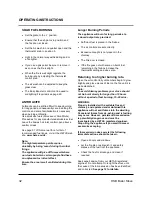
19
HSB Boiler Stove
INSTALLATION
WATER CONNECTIONS
Heating system
The size of the heating system that can be run
will depend on the output rating of the appliance.
It will be necessary to work out the heat loss
calculations for the system proposed in order to
establish the kW / Hr rating. An appliance that will
meet this figure should be chosen. (For boiler
outputs please refer to the sales brochures).
The constructional requirements of installing and
connecting the appliance also need to be taken
into account when selecting. Design calculations
for individual heating systems should be carried
out by a qualified heating engineer. In many
cases your supplier will be able to offer advice
and assistance.
Direct Systems
The
HSB Boiler Stove
is
NOT
suitable for con-
necting to
Direct
domestic hot water systems.
They are designed for use with
Indirect
vented
central heating systems only.
Indirect Systems
The Domestic Hot Water Circuit
To connect the indirect hot water cylinder use
28mm copper pipes. Ensure that the pipes rise
continuously to the cylinder.
Ensure that runs are not to long, i.e. 6 metres
maximum each for flow and return. Install the
cylinder above the level of the fire, and as close
to it as possible (within reason the higher the
cylinder the faster the circulation).
Ensure no valves are present in the pipes.
In addition to providing hot water the primary
circuit is essential in providing a ‘Heat Leak’
radiator to absorb excessive heat produced in the
event of the circulating pump shutting down.
Heat is produced in varying quantities while the
stove is alight and care must be taken to ensure
that effective circulation can occur around the
primary circuit to carry the heat away and thus
prevent boiling.
The output of any radiator installed as a ‘Heat
Leak’ should not be less than 10% of the rated
output of the appliance to which it is connected.
The radiator should not be fitted with a control
valve as it should never be turned off or down.
The hot water cylinder must be indirect with a
minimum capacity of 110 litres, conforming to
BS 1566 part 1.
A radiator of approximately 2 m² surface area
should be connected into the primary circuit.
If installed in the bathroom it provides a means of
drying towels in the summer.
Safety Vent Circuit
This circuit consists of a cold feed pipe and a
separate expansion pipe, and expansion tank.
The possibility that water in the stove boiler may
boil can never be completely ruled out, and it is
therefore vital to ensure that cold water can be
provided to the boiler and steam vented from it at
all times.
The expansion tank should have a capacity of at
least 7% of the systems total water capacity. The
cold water feed pipe should be at least 22mm in
diameter.
There must not be any shut-off valves in the
circuit. Pipes should be run so as to avoid air
locks. A safety relief valve should be fitted into
the expansion pipe close to the boiler. The
expansion pipe should not be branched off from
the cold water feed pipe to ensure it cannot be
blocked by any settlement matter originating from
the expansion tank.
It is often possible and good practise to utilise the
primary flow and return as part of the safety
circuit. The ball valve should be copper, the
overflow pipe from the expansion tank should be
28mm diameter copper. All pipes in unheated
spaces must be lagged.
Various installation examples can be seen on
pages 16 & 17.






























